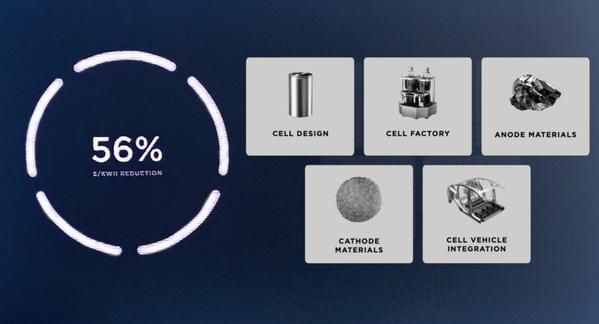Continued: Tesla 4680 Battery-Battery Technology Upgrade-Part 4.
2.2.4. Actual performance of 4680 cell
As the size of the battery increases, the number of batteries in the battery pack decreases, the proportion of the metal casing decreases, the proportion of materials such as the cathode electrode and the anode electrode increases, and the energy density increases.
Compared with the 2170 battery, the energy of the 4680 battery has increased by 5 times. The current increase in cruising range (16%) is mainly due to CTC technology (14%). With the continuous upgrading of the material system, the battery energy density has room for further improvement.

Performance of all tab 4680 cell
3. Dry battery technology
Dry electrode technology can be used on both cathode and anode electrodes.
3.1. Traditional wet process
The material needs to be placed in the solution, and then dried and pressed into a film: use a solvent with a binder material, of which NMP is one of the common solvents, and the solvent with the binder is combined with the anode electrode or After the cathode electrode powder is mixed, the slurry is coated on the electrode current collector and dried.
The solvent is poisonous and needs to be recovered, purified and reused. A huge, expensive and complicated electrode coating machine is needed in the middle.
3.2. Dry cell process
The dry electrode process completely skips the step of adding solution, can omit complicated coating, drying and other processes, greatly simplifying the production process: mix the active cathode and anode particles with (PTFE) polytetrafluoroethylene to make it fiber and directly, the powder is rolled into a film and pressed onto aluminum foil or copper foil to prepare cathode and anode electrodes.
3.3. Advantages of dry battery
- The process is simple and cost-saving: no solvent is used, eliminating the need for expensive coating machines.
- Improve production efficiency: Dry electrode technology increases the production speed to seven times the previous.
- Increase battery energy density: In the presence of solvents, lithium and carbon mixed with lithium metal cannot blend well with each other, and there is a problem of capacity loss in the first cycle.
Dry battery technology will greatly improve this problem, thereby increasing battery energy density.
At the same time, increase the thickness of the positive electrode material from 55μm to 60μm to increase the active electrode material ratio, increase the energy density by 5%, and ensure the power density.
3.4. Difficulties in dry battery process
The current technology is immature, the battery needs to be thick, and the cylinder needs to be rolled up, which is easy to crack.
……To be continued
 +8613906047998
+8613906047998




